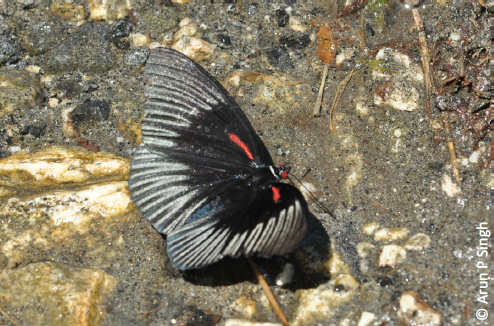 |
| The Empress, (Sasakia funebris) spotted from Debang Valley District in Arunachal Pradesh (Photo Courtesy: JOTT/Arun P Singh) |
All he was able to get were two quick pictures. It never came back, despite patient wait for long hours. But the pictures were worth it, since they
are the first of a live Empress to be recorded from the country. The moment was simply unbelievable for the
researcher who accidentally met The Empress, (Sasakia funebris) from Upper Debang
Valley District of Arunachal Pradesh, since it was going to be the first record
of the rare butterfly from India after 88 years.
Arun P. Singh of Ecology & Biodiversity Conservation Division, Rain Forest Research Institute, Jorhat, Assam was carrying out a survey on ‘Reassessment of forest types of India’ in the Upper Debang Valley District of Arunachal Pradesh when he chanced upon this rare butterfly on the side of the Anini-Mippi Road. During the survey, “this species was incidentally photographed on the road side and later identified”, says the research correspondence regarding the rediscovery published in the Journal of Threatened Taxa. The butterfly “preferred to remain in cover but came down to an eroded mud patch along the road to drink during bright sunshine for a minute or so before disappearing again into thick cover above”, says the researcher in the correspondence.
Arun P. Singh of Ecology & Biodiversity Conservation Division, Rain Forest Research Institute, Jorhat, Assam was carrying out a survey on ‘Reassessment of forest types of India’ in the Upper Debang Valley District of Arunachal Pradesh when he chanced upon this rare butterfly on the side of the Anini-Mippi Road. During the survey, “this species was incidentally photographed on the road side and later identified”, says the research correspondence regarding the rediscovery published in the Journal of Threatened Taxa. The butterfly “preferred to remain in cover but came down to an eroded mud patch along the road to drink during bright sunshine for a minute or so before disappearing again into thick cover above”, says the researcher in the correspondence.
With a wing span of 125 to 130 mm, the butterfly is comparatively
larger and very distinctive with its black colour and red eyes. The forewing
cell (the middle portion of the butterfly wing) has a red streak while the hind
wing has red markings in the base. The outer halves of the wings of this
butterfly have dim white streaks in V shape also.
Historical Records of
The Empress from India
Though the butterfly is also found in parts of China, records from
India are very scarce. Considered very rare among the winged beauties, The Empress
was last reported from India in 1924, when British entomologist O C Ollenbach
collected a male specimen from Jakhama in Naga Hills which is now preserved in
the National Forest Insect Reference Collection at the Forest Research
Institute in Dehradun. Earlier, four specimens of the same butterfly were
reportedly collected at Jakhama in Naga Hills in 1911 and 1912. In both the
cases, it was reported from altitudes higher than 1500 meters.
The present rediscovery has high conservation significance since extensive
surveys of butterfly population in neighbouring states of North East India and
Myanmar in the recent past have failed to record the presence of the species. The
new record is also an extension to the range of this insect since the place is approximately
200 kilometers away from Naga Hills and is situated in a different hill range
at an altitude of 1657 meters. According to the researcher, the area of the
rediscovery was mixed sub-tropical broad-leaf forest. The species is protected
in India with inclusion in the Schedule I of Wildlife (Protection) Act,
1972.
The place from which it is recorded is less disturbed by human
intervention, says the research communication. “Biotic interference were low
although threats to the forests in the area include shifting cultivation,
grazing, fuel wood and timber extraction on a minor scale”, it says. However, the insect is a much sought item for insect smuggling rackets since it costs up to $15 dollars for a single individual in the international
curios markets.


Impressive-though an empress-this one has witch-like coloring.
ReplyDeleteNice to hear about this rediscovery.
ReplyDeleteDhirendra Swarup
it's gorgeous with its rare color
ReplyDeleteNice pics and lovely narration..:-)
ReplyDeleteit looks so much like the swallow tail butterfly.
ReplyDeleteHi all,
ReplyDeleteThanks for the comments. Glad to know that you are happy to hear about the rediscovery and to look at this winged beauty.
@Indrani, But it is a Nymphalid, not Swallowtail.